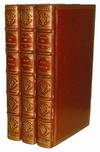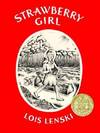
La Morosophie… Contenant Cent Emblèmes moraux, illustrez de Cent Tetrastiques Latins, réduitz en autant de Quatrains Francoys.
by LA PERRIERE, Guillaume de
- Used
- Hardcover
- first
- Condition
- See description
- Seller
-
Paris, France
Bibliophiles Club Membership
Payment Methods Accepted
About This Item
Lyon, Macé Bonhomme, 1553.
8vo [157 x 100 mm] of (13) ll. and 100 numbered ll., title slightly shorter at the bottom, vignettes 90 and 91 partially colored in blue.
Brown morocco, double frame of blind-stamped fillets with gilt fleurons in the corners and decoration at the centre, spine ribbed and decorated with gilt fleurons, inner gilt fillet border, gilt edges. Binding signed by Capé.
First edition and first issue of this very beautiful illustrated collection of emblems.
Adams L-172 ; Brunet, III, 830 ; Rothschild, V, 3328 ; Brun, 232 ; Vinet 841 ; Landwehr, Romanic, 454.
Dedicated to Antoine de Bourbon, Duke of Vendomois to whom 2 epistles are addressed, this book of 'crazy wisdom' is preceded by a couplet and a quatrain by Bernardo Poggio, a sonnet by Guillaume de Caynet and a decima by Jacques de Maulevant.
It was the second illustrated work of its kind composed by this poet and historian from Toulouse, after 'Le Théâtre des bons engins' published in 1539.
The present collection is composed of 100 moralities in Latin and French in the form of quatrains:
" L'arbre sauvage infertil par nature
Ne faut du tout couper ou desplanter
Mais le convient par art d'agriculture
De quelque plant, qui soit fertil, enter " (28).
" Le cheval prent bride, mordz & chevestre
Pour se venger plus aisément du cerf
Puis se reprend (disant) qu'il fait bon estre
En liberté, au pris que d'estre cerf "
Following a full-page portrait of the author, dated 1552, the illustration consists of a suite of 101 vignettes (71x52 mm or 73x56 mm).
The first is a representation of Time, each of the other 100 is an illustration of one of the emblems.
In addition to a few references to Antiquity, such as the Trojan horse, all of the figures mainly give us scenes of everyday life in the 16th century: hunting, fishing, preparing flax, plowing, cultivating in a garden, feast, doctors at the bedside of a sick person, harvest of fruits, sculptor, carpenter, dance to the sound of the flute, defense against the boar, nave in the storm...
All the pages are framed with pretty, varied borders of foliage, fauna, characters, animals, porticoes, masks and fruits.
Some are signed IM or IP and a few dated 1551.
It seems that the sober and lightly shadowed line of the figures is due to Jean Mounier and Jean Perrin and engraved by Guiraud Adret.
The title page, in the form of a cartouche, is adorned with caryatids, cupids and grotesque figures.
Precious copy finely bound by Capé towards 1855.
Français :
Lyon, Macé Bonhomme, 1553.
In-8 de (13) ff. et 100 ff. numérotés, titre très légèrement plus court dans la partie basse, vignettes 90 et 91 partiellement coloriées en bleu.
Maroquin brun, double encadrement de filets à froid avec fleurons dorés aux angles et motif décoratif au centre, dos à nerfs orné de fleurons dorés, filet or sur les coupes, roulette intérieure dorée, tranches dorées. Reliure signée de Capé.
157 x 100 mm.
Première édition et premier tirage de ce très joli recueil d'emblèmes illustré.
Adams L-172 ; Brunet, III, 830 ; Rothschild, V, 3328 ; Brun, 232 ; Vinet 841 ; Landwehr, Romanic, 454.
Dédié à Antoine de Bourbon, Duc de Vendomois auquel sont adressés 2 épîtres, ce livre de 'folle sagesse' est précédé d'un distique et d'un quatrain de Bernardo Poggio, d'un sonnet de Guillaume de Caynet et d'un dizain de Jacques de Maulevant.
C'était le deuxième ouvrage illustré du genre composé par ce poète et historien Toulousain, après 'Le Théâtre des bons engins' paru en 1539.
Le présent recueil est composé de 100 moralités en latin et en français sous forme de quatrains :
" L'arbre sauvage infertil par nature
Ne faut du tout couper ou desplanter
Mais le convient par art d'agriculture
De quelque plant, qui soit fertil, enter " (28).
" Le cheval prent bride, mordz & chevestre
Pour se venger plus aisément du cerf
Puis se reprend (disant) qu'il fait bon estre
En liberté, au pris que d'estre cerf ".
A la suite d'un portrait à pleine page de l'auteur, daté de 1552, l'illustration se compose d'une suite de 101 vignettes (71 x 52 mm ou 73 x 56 mm).
La première est une représentation du Temps, chacune des 100 autres est une illustration de l'un des emblèmes.
Outre quelques références à l'Antiquité, tel le cheval de Troie, l'ensemble des figures nous livre essentiellement des scènes de la vie quotidienne au XVIe siècle : chasse, pêche, préparation du lin, labour, cultures dans un jardin, festin, médecins au chevet d'un malade, récolte des fruits, sculpteur, charpentier, danse au son de la flute, défense contre le sanglier, nef dans la tempête…
Toutes les pages sont encadrées de jolies bordures variées de rinceaux, faunes, personnages, animaux, portiques, maques et fruits.
Certaines sont signées IM ou IP et quelques-unes datées de 1551.
Il semble que le trait sobre et peu chargé d'ombres des figures soit dû à Jean Mounier et Jean Perrin et gravé par Guiraud Adret.
La page de titre en forme de cartouche est ornée de cariatides, d'amours et de figures grotesques.
Précieux exemplaire finement relié vers 1855 par Capé.
Reviews
(Log in or Create an Account first!)
Details
- Bookseller
- LIBRAIRIE CAMILLE SOURGET
(FR)
- Bookseller's Inventory #
- NY06
- Title
- La Morosophie… Contenant Cent Emblèmes moraux, illustrez de Cent Tetrastiques Latins, réduitz en autant de Quatrains Francoys.
- Author
- LA PERRIERE, Guillaume de
- Book Condition
- Used
- Quantity Available
- 1
- Binding
- Hardcover
- Weight
- 0.00 lbs
Terms of Sale
LIBRAIRIE CAMILLE SOURGET
About the Seller
LIBRAIRIE CAMILLE SOURGET
About LIBRAIRIE CAMILLE SOURGET
Glossary
Some terminology that may be used in this description includes:
- Edges
- The collective of the top, fore and bottom edges of the text block of the book, being that part of the edges of the pages of a...
- Title Page
- A page at the front of a book which may contain the title of the book, any subtitles, the authors, contributors, editors, the...
- Spine
- The outer portion of a book which covers the actual binding. The spine usually faces outward when a book is placed on a shelf....
- Morocco
- Morocco is a style of leather book binding that is usually made with goatskin, as it is durable and easy to dye. (see also...
- Gilt
- The decorative application of gold or gold coloring to a portion of a book on the spine, edges of the text block, or an inlay in...







